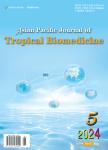Microbiological assessment of indoor air of a teaching hospital in Nigeria
Microbiological assessment of indoor air of a teaching hospital in Nigeria作者机构:Department of Microbiology Olabisi Onabanjo University Department of Medical Microbiology & Parasitology Olabisi Onabanjo University Teaching Hospital Department of Plant Science & Applied Zoology Olabisi Onabanjo University
出 版 物:《Asian Pacific Journal of Tropical Biomedicine》 (亚太热带生物医学杂志(英文版))
年 卷 期:2012年第2卷第6期
页 面:465-468页
学科分类:0710[理学-生物学] 0831[工学-生物医学工程(可授工学、理学、医学学位)] 1004[医学-公共卫生与预防医学(可授医学、理学学位)] 100401[医学-流行病与卫生统计学] 10[医学]
主 题:Indoor air OOUTH Open-plate technique Nosocomial infections Staphylococcus aureus Microbiological assessment Microbial quality Bacterial isolate Fungal isolate Opportunistic pathogen Nosocomial infection Infection rate Microbial isolate Penicilliumsp Sedimentation technique
摘 要:Objective:To investigate the quality of indoor air of different wards and units of Olabisi Onabanjo University Teaching Hospital, Sagamu, to ascertain their contribution to infection rate in the hospital.Methods:The microbial quality of indoor air of nine wards/units of Olabisi Onabanjo University Teaching Hospital, Sagamu, Nigeria was conducted. Sedimentation technique using open Petri-dishes containing different culture media was employed and samplings were done twice daily, one in the morning shortly after cleaning and before influx of people/patients into the wards/units and the other in the evening when a lot of activities would have taken place in these wards. Isolates were identified according to standard methods.Results:Results showed that there was a statistically significant difference(氈2= 6.0167) in the bacteria population of the different sampling time whereas it was not so for fungi population(氈2= 0.2857). Male medical ward(MMW) and male surgical general(MSG) recorded the highest bacterial and fungal growth while the operating theatre(OT) was almost free of microbial burden. The bacteria isolates were Staphylococcus aureus, Klebsiellasp., Bacillus cereus, Bacillus subtilis, Streptococcus pyogenes andSerratia marscenceswhile the fungi isolates includedAspergillus flavus, Penicilliumsp.,Fusariumsp.,Candida albicansandAlternariasp.Staphylococcus aureuswas the predominantly isolated bacterium whilePenicilliumsp. was the most isolated fungus.Conclusions:Though most of the microbial isolates were potential and or opportunistic pathogens, there was no correlation between the isolates in this study and the surveillance report of nosocomial infection during the period of study, hence the contribution of the indoor air cannot be established. From the reduction noticed in the morning samples, stringent measures such as proper disinfection and regular cleaning, restriction of patient relatives movement in and out of the wards/units need to be enforced so as to improve the quality of indoor air of our hospital wards/units.



